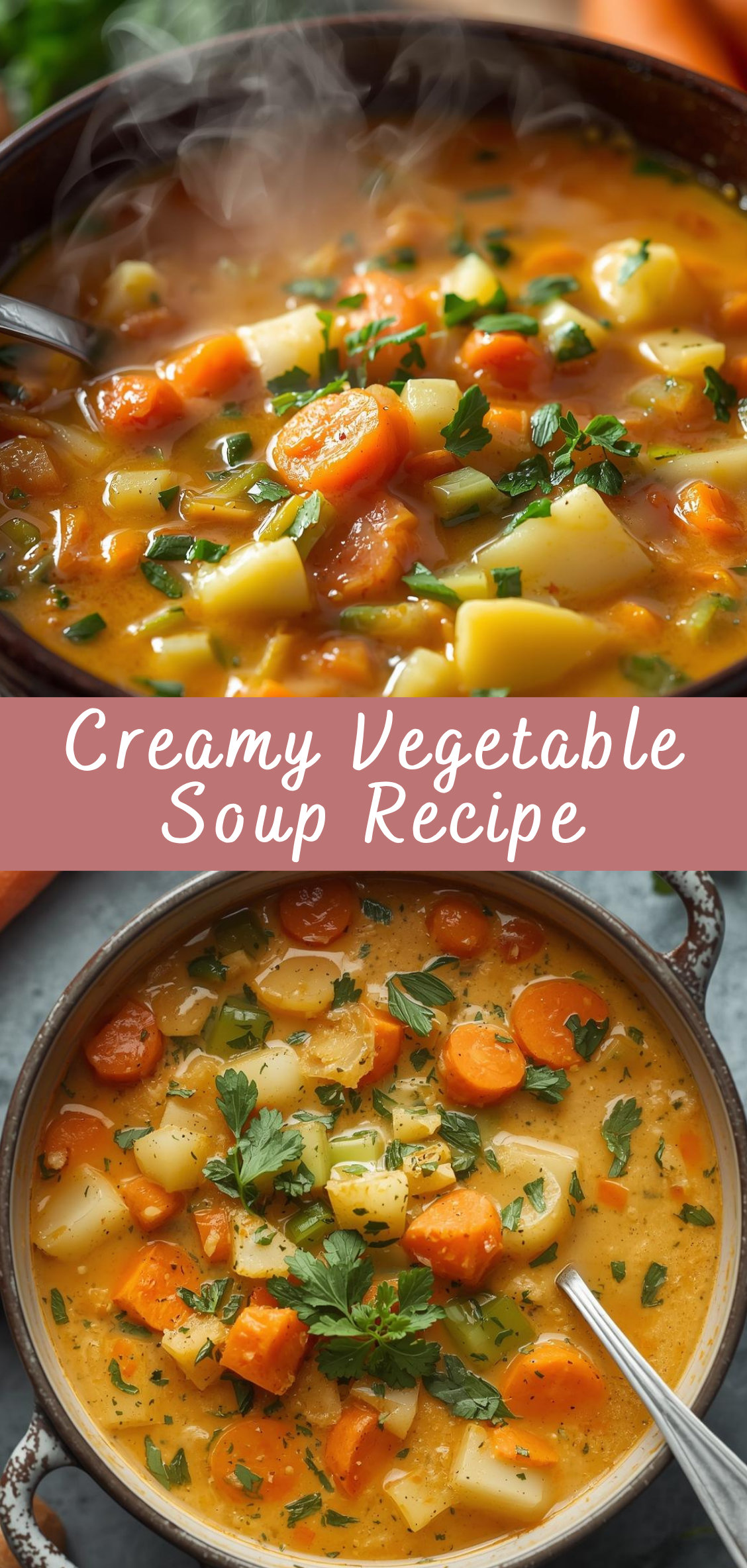Creamy Vegetable Soup Recipe
A Comforting Classic That Marries Fresh Vegetables, Silky Texture, and Soulful Warmth
There are few dishes that embody comfort quite like a bowl of creamy vegetable soup. From the first spoonful, it delivers the kind of warmth that seeps deep into the spirit — velvety, nourishing, and layered with the earthy sweetness of garden-fresh produce. It’s the kind of soup that feels like home: humble in ingredients, yet elegant in execution; simple in preparation, yet rich in flavor. Whether it’s the chill of a late autumn evening or the quiet need for a soothing meal after a long day, creamy vegetable soup offers a sense of restoration that few dishes can match.

At its heart, this recipe celebrates the beauty of vegetables — carrots, potatoes, celery, peas, corn, leeks, and whatever else the season brings. When simmered slowly in a fragrant broth, their natural sugars develop, their textures soften, and their colors deepen into a vibrant tapestry of golds, greens, and oranges. Then comes the transformation: a swirl of cream or milk that turns the broth into something luxuriously smooth and satisfying. The result is a soup that feels indulgent without being heavy, nourishing without being plain, and familiar while still leaving room for creativity.
The Creamy Vegetable Soup is more than just a recipe — it’s a canvas. You can adapt it with seasonal produce, enrich it with herbs, or adjust its consistency to your liking. Want it hearty and chunky? Leave the vegetables whole for rustic charm. Prefer it smooth and refined? Blend it to a satiny purée. You can make it entirely vegetarian, or add depth with chicken or vegetable stock. The possibilities are endless, yet the essence remains the same: a soup that celebrates flavor, balance, and warmth.
What sets this particular recipe apart is the attention to texture and layering. Every step — from sautéing the aromatics in butter to slowly simmering the vegetables, to blending and seasoning — is designed to extract maximum depth of flavor. The creamy base is built gradually, not rushed, allowing each vegetable to contribute its unique note. A hint of garlic provides subtle heat; thyme and bay leaf lend earthy undertones; a touch of cream or half-and-half rounds everything out with silky smoothness.
This soup is equally suited for a casual weekday dinner as it is for a refined starter at a holiday table. Pair it with a slice of crusty bread, a sprinkle of grated cheese, or a drizzle of olive oil, and you have a meal that feels both complete and deeply comforting. Beyond taste, it’s also a celebration of nourishment — packed with vitamins, fiber, and natural antioxidants that make every bite as wholesome as it is delicious.
In this comprehensive guide, we’ll dive into every detail of creating the perfect creamy vegetable soup: selecting the right ingredients, understanding the cooking techniques that bring out the best flavors, mastering the art of blending, and customizing the soup to suit your tastes or dietary preferences. We’ll also explore flavor variations — from classic cream-based versions to dairy-free adaptations using cashew cream or coconut milk.
Whether you’re a seasoned home cook or just beginning your culinary journey, this recipe will show you that great soup doesn’t come from a can or carton — it comes from time, patience, and care. A pot of Creamy Vegetable Soup simmering on the stove isn’t just food; it’s an act of love, a ritual of comfort, and a reminder that even the simplest ingredients can be transformed into something extraordinary.
Detailed Cooking Instructions
A good creamy vegetable soup isn’t made by simply boiling vegetables and adding cream. The secret lies in layering flavors, controlling texture, and balancing richness. Each stage of cooking — from sautéing the aromatics to blending the finished soup — plays a role in building depth and harmony. The following steps will guide you through crafting a soup that’s smooth, flavorful, and deeply satisfying.
Step 1: Gather and Prepare Your Ingredients
The beauty of this soup lies in its flexibility. You can adapt it to the season or to what’s available in your pantry. Still, a solid base ensures a balanced flavor profile and creamy consistency.
Core Ingredients:
-
Butter or olive oil: 3 tablespoons (for sautéing; butter adds richness, olive oil gives a lighter taste)
-
Onion: 1 large, finely chopped
-
Leeks: 1 small, white and light green parts only, cleaned and sliced thin
-
Carrots: 2 medium, diced
-
Celery: 2 stalks, diced
-
Garlic: 3 cloves, minced
-
Potatoes: 2 medium (Yukon Gold or russet), peeled and cubed
-
Cauliflower florets: 2 cups (optional, for creaminess)
-
Green beans, corn, or peas: 1 cup (for texture and color)
-
Vegetable stock or broth: 5–6 cups
-
Heavy cream or half-and-half: 1 cup (or substitute with milk for a lighter version)
-
Salt: 1 ½ teaspoons (to taste)
-
Black pepper: ½ teaspoon (freshly ground preferred)
-
Bay leaf: 1
-
Fresh thyme or dried thyme: 1 teaspoon
-
Fresh parsley: for garnish
Optional ingredients for variation:
-
A splash of white wine (to deglaze and add acidity)
-
A pinch of nutmeg (enhances creaminess and warmth)
-
Parmesan cheese or nutritional yeast (for umami depth)
-
A handful of spinach or kale (added near the end for color and nutrition)
Preparation:
-
Wash, peel, and dice all vegetables into roughly uniform sizes to ensure even cooking.
-
Mince garlic and chop herbs.
-
Measure out your broth and cream so everything is ready to go — soup moves quickly once it starts cooking.
Step 2: Sauté the Aromatics
The foundation of all great soups is a flavor base — typically a combination of aromatics cooked slowly in fat to release their sweetness.
-
In a large soup pot or Dutch oven, melt the butter (or heat olive oil) over medium heat.
-
Add the onion, leek, carrot, and celery. Sauté gently for about 7–8 minutes, stirring occasionally, until the vegetables soften and begin to turn translucent. You’re not trying to brown them — you want slow, gentle cooking that draws out natural sugars.
-
Add the garlic and cook for another 30 seconds to 1 minute, stirring constantly until fragrant.
This process, called sweating, forms the aromatic core of the soup — it’s what gives it that deep, savory background note that lingers in every spoonful.
Step 3: Add the Root Vegetables and Herbs
Next, introduce your heartier vegetables — those that take longer to soften and will help give body to the soup.
-
Stir in the potatoes and cauliflower florets (if using). These will later contribute to the creamy texture once blended.
-
Season lightly with salt, pepper, and thyme.
-
Add the bay leaf for a subtle, woodsy undertone.
-
Stir everything together for about 2 minutes so the vegetables are well coated in butter and herbs.
At this stage, if you’re using white wine, pour in about ¼ cup to deglaze the pot. Scrape up any browned bits from the bottom — that’s flavor. Let the wine simmer for a minute until most of it evaporates.
Step 4: Pour in the Broth and Simmer Slowly
-
Add 5–6 cups of vegetable broth (or chicken broth if you prefer a richer taste).
-
Bring the mixture to a gentle boil, then immediately reduce the heat to low.
-
Cover the pot partially with a lid and let the soup simmer for 20–25 minutes, or until the potatoes and carrots are very tender when pierced with a fork.
During this time, the vegetables release their starches into the broth, naturally thickening it and deepening the flavor. Stir occasionally to prevent sticking.
Step 5: Add Tender Vegetables and Adjust Seasoning
-
Once the base vegetables are soft, add the peas, corn, or green beans.
-
Continue simmering for another 5–7 minutes until these vegetables are just cooked — tender but still vibrant.
-
Taste the soup at this stage and adjust salt and pepper as needed.
The goal here is to balance the saltiness of the broth with the natural sweetness of the vegetables. If it tastes flat, a small squeeze of lemon juice or an extra pinch of salt can make the flavors pop.
Step 6: Create the Creamy Base
Now comes the moment where your soup transforms from a simple vegetable broth to a luscious, creamy delight. You have two main options:
Option 1: Smooth and Silky (Blended Version)
-
Remove the bay leaf from the pot.
-
Use an immersion blender directly in the pot to purée the soup until smooth. For an ultra-silky texture, blend in batches using a countertop blender, then return the soup to the pot.
-
Once blended, pour in 1 cup of heavy cream (or milk for a lighter version) and stir gently over low heat. Do not boil after adding cream — it can curdle.
-
Taste again for seasoning and adjust with salt, pepper, or a pinch of nutmeg for warmth.
Option 2: Rustic and Chunky
If you prefer texture in your soup, remove about one-third of the mixture before blending. Purée the remaining two-thirds until smooth, then stir the reserved portion back in. This method gives you both body and bite — a satisfying combination.
Step 7: Enrich and Customize
This step allows you to turn the soup into your own personal creation. Depending on your preference or dietary needs:
-
Stir in a handful of baby spinach or kale just before serving for color and freshness.
-
Sprinkle grated Parmesan cheese or a spoonful of nutritional yeast for umami depth.
-
For a dairy-free option, use coconut milk or cashew cream instead of dairy.
-
Add a swirl of herb-infused oil (like basil or parsley oil) for a gourmet finish.
Allow the soup to rest for 5–10 minutes before serving. This pause helps the flavors meld together into a cohesive whole.
Step 8: Serving and Presentation
Presentation matters — even for a humble soup. Serve your Creamy Vegetable Soup in warm bowls, garnished with:
-
A drizzle of cream or olive oil
-
A sprinkle of freshly chopped parsley or chives
-
Cracked black pepper on top
-
A few homemade croutons or toasted seeds for crunch
Pair it with:
-
Crusty bread or garlic toast for dipping
-
A light salad with lemon vinaigrette
-
A grilled cheese sandwich for a cozy, balanced meal
Creamy Vegetable Soup Recipe
There are few dishes that embody comfort quite like a bowl of creamy vegetable soup. From the first spoonful, it delivers the kind of warmth that seeps deep into the spirit — velvety, nourishing, and layered with the earthy sweetness of garden-fresh produce. It’s the kind of soup that feels like home: humble in ingredients, yet elegant in execution; simple in preparation, yet rich in flavor. Whether it’s the chill of a late autumn evening or the quiet need for a soothing meal after a long day, creamy vegetable soup offers a sense of restoration that few dishes can match.
Ingredients
- 2 tablespoons butter (or olive oil)
- 1 medium onion, chopped
- 2 garlic cloves, minced
- 2 medium carrots, diced
- 2 stalks celery, diced
- 1 medium potato, peeled and diced (Yukon gold or russet)
- 1 small zucchini, diced
- 1 cup broccoli florets (or cauliflower)
- 1 cup corn kernels (fresh or frozen)
- 4 cups vegetable broth (or chicken broth)
- 1 teaspoon salt, or to taste
- ½ teaspoon black pepper
- 1 teaspoon dried thyme (or Italian seasoning)
- ½ teaspoon paprika (optional)
- 1 cup milk or half-and-half
- ½ cup heavy cream (optional, for extra creaminess)
- 2 tablespoons all-purpose flour (for thickening)
- Fresh parsley or chives, chopped (for garnish)
Instructions
- Sauté the aromatics:
In a large pot, melt butter over medium heat.
Add onion, garlic, carrots, and celery; cook for 5–6 minutes, until softened and fragrant. - Add the vegetables:
Stir in potato, zucchini, broccoli, corn, salt, pepper, thyme, and paprika.
Cook for 2–3 minutes, stirring occasionally. - Add broth and simmer:
Pour in vegetable broth.
Bring to a boil, then reduce heat and simmer for 15–20 minutes, until vegetables are tender. - Thicken the soup:
In a small bowl, whisk flour into milk until smooth (no lumps).
Stir mixture into the soup and simmer 5–7 minutes more, until thickened. - Make it creamy:
Stir in heavy cream (if using).
Adjust seasoning with additional salt and pepper to taste. - Blend (optional):
For a smoother texture, use an immersion blender to partially or fully puree the soup.
Leave some chunks if you like a more rustic texture. - Serve:
Ladle into bowls and garnish with fresh parsley or chives.
Serve with crusty bread or crackers.
Notes
- Make it vegan: Use olive oil instead of butter and plant-based milk/cream (like oat or cashew milk).
- Add protein: Stir in cooked beans (white beans, lentils) or shredded chicken.
- Flavor boosters: Add a splash of lemon juice or a pinch of nutmeg before serving.



